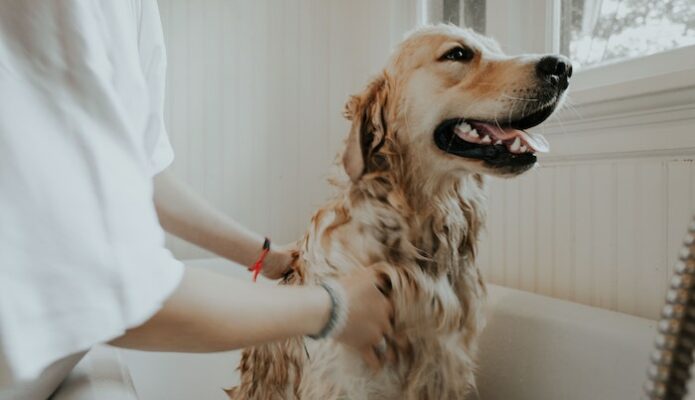
Regular grooming doesn’t just make your dog’s fur look pretty, but it can also keep your pooch healthy. Keeping your dog’s coat clean can also help you spot any concerns. Here are seven tips for grooming your dog at home:
Brush your dog’s coat regularly.
It doesn’t matter which dog breed you have — brushing your dog’s coat regularly can help prevent matting. Matting can cause pain and irritation, so it’s important that you unmat your dog’s coat as often as possible. Regular brushing can also help you keep your dog’s coat looking glossy and healthy. The number of times you brush your dog’s coat per week depends on your dog’s breed, their coat length, and their coat texture.
Breeds with longer coats — like collies and golden retrievers — require regular brushing (at least once a week, but preferably every other day). Breeds that have shorter fur — like Labrador retrievers and greyhounds — need for you to brush them every other week. Brushing your dog can also remove dander, dirt, and loose hair, which can extend the amount of time you can wait between baths.
Trim your dog’s hair.
Most dog owners will find it easier to take their dogs to a professional groomer than to cut their fur at home, but you can still give your pup a great home haircut! When you trim your dog’s coat, concentrate on the area around their eyes and paws. Overgrown hair around the eyes can cause vision issues and infections. Your dog’s fur can also rub against their eyes and cause damage.
Before you give your dog a trim, head to a comfortable room where your dog won’t slip. Also, make sure that the scissors you use are sharp enough to avoid tugging. This can ensure that the trimming will go quickly and smoothly.
Be careful when you trim the fur around your dog’s ears. This step is important, though, because it can help prevent ear infections and improve your dog’s hearing.
Always reward your dog with a treat for being calm during the trimming. Also, make sure not to cut too close to the skin, and do not trim your dog’s coat at home if you aren’t confident about doing it.
Brush your dog’s teeth.
Oral health is as important for dogs as it is for humans. Dogs’ teeth can retain odors if you don’t care for them properly. Brushing your dog’s teeth can help eliminate bad breath, remove plaque and tartar, and prevent gum disease. These benefits are a significant part of your dog’s health, so you should learn how to brush your dog’s teeth well.
Even if you have the right toothpaste for your dog, coaxing your pooch to open their mouth can be difficult. To avoid the hassle, you can learn how to clean your dog’s teeth without brushing them. There are plenty of ways to do a great job of cleaning your dog’s teeth without the struggle.
Bathe your dog regularly.
Regular bathing can help keep your dog’s coat clean and help prevent matting too. Make sure that their coat is free from knots before you bathe your dog because knots can cause matting and pain when you start your wash.
Dogs with healthy fur and skin only need baths once every month or two. Bathing your dog more regularly will strip their coat of its natural oils, which can dry out both the coat and the skin.
Before you bathe your dog, check to see if they smell unusual or unpleasant.If they smell but have not come into contact with anything smelly, they may have an infection. If your dog smells without a clear reason, take them to the vet for a checkup before you bathe them.
Check your dog’s skin and ears during grooming.
Skin conditions and allergies are fairly common in dogs. They can cause itching, which can make your dog bite and claw their skin. These symptoms can make your dog miserable and may also cause further disease.
Check your dog’s skin every time you groom them. Run your fingers through their coat and check for lumps and bumps. Also, check if your dog has any bald spots — these can indicate biting and scratching.
Next, check your dog’s ears. Ear infections are often painful for your dog, and you should treat them as soon as possible. Look for excess discharge, ear scratching, a sweet smell in the ear, or moisture or inflammation inside of the ear.
Clip your dog’s nails.
Long nails can be uncomfortable for your dog, so check your dog’s paws regularly to ensure that their nails aren’t too long. Remember that your dog’s nails shouldn’t touch the floor when they’re standing. Listen to the sound of your dog walking — a clicking sound means that your dog’s nails are too long. Be sure to cut your dog’s nails every three to six weeks, depending on how quickly your dog’s nails grow.
Grooming your dog at home is completely doable. If you don’t want to shell out extra cash at the doggie salon, use these tips to pamper your furry friend in the comfort of your own home.
Photo by Autri Taheri on Unsplash



















A Maltipoo dog is a small and adorable crossbreed dog that is a mix between a Maltese and a Toy or Miniature Poodle. This popular designer breed combines the best traits of its parent breeds, resulting in a friendly, affectionate, and playful companion. Maltipoos are known for their fluffy, hypoallergenic coats, making them an excellent choice for individuals with allergies.